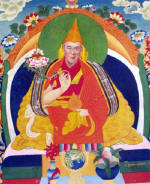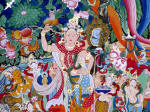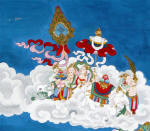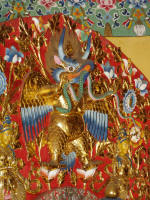 |
 | ||||||||||||||||||
| |||||||||||||||||||
|
The Library of Tibetan Works And Archives Tibetan Institute Of Performing Arts |
Dharamsala A Guide to Little Lhasa in India Dharamsala Image by P r Bali Mcleodganj (1700 mt) Photo Gallery9 km up from Kotwali Bazar Dharamsala is the famous town Mcleodganj often called the ‘Little Lhasa’. This is the residence of HH the Dalai Lama. The Tibetan Government in exile has been here for almost four decades. The impressive monastery has larger than life images of the Buddha, Padmasambhava and Avalokteshwara. A large Tibetan community and the presence of traditional architectural designs drawn from Tibet have enhanced the charm of the area. A host of Tibetan handicrafts and garments are available. Tsuglag Khang (Central
Cathedral)
|
||||||||||||||||||
Situated opposite the residence of His Holiness the Dalai Lama,Tsuglag Khang is known to the local Indians as the Main Temple. It houses three main images: thatof the Sakyamuni Buddha, Padmasambhava and Avalokitesvara, the Buddha of Compassion, of whom the Dalai Lama is the current emanation. The principal image is that of Sakyamuni Buddha, measuring three metres high and made of gilded bronze. To its right are the images of Padmasambhava and Avalokitesvara which are both facing Tibet.Naam Art Gallery
Naam Art Gallery is a popular tourist spot situated in McLeodganj city. There are various paintings and exhibitions on display in this art gallery. These paintings are works of the renowned German painter Elsbeth Buschmann and English painter A.W. Hallett. It is situated in Sidhbari village, which is on the main Dalhousie-Chamunda Road. Original paintings, exclusive art prints framed or unframed and art cards can also be purchased from this art gallery at a reasonable price. Namgyalma StupaSurrounded by prayer wheels, this Buddhist stupa, is located in
the centre of McLeod Gunj. Erected as Church Of St. John In TheWilderness
Fifteen
minutes' walk from McLeod Gunj, the Anglican church lies in the forest
near Forsyth Gunj. This neo-Gothic stone church was built in 1852 and has
some fine Belgian stained-glass windows. It miraculously survived the 1905
earthquake - only the spire collapsed. A memorial to Lord Elgin stands in
the churchyard. The British Viceroy died in Dharamsala and is buried here.
Visiting hours for the church and cemetery are 10 am to 5 pm each
day. Dal LakeAbout three kilometers from McLeod Gunj and next to the Tibetan Children's Village, this small lake is brownish in colour and not nearly as impressive as the name and reputation suggest. However, there are many interesting walks around the lake.
Triund
Mcleodganj to Triund is a 9 km
gradual trek which passes through the Dharmkot and Rakkar villages.
Chinmaya Tapovan:- An ashram complex has been established by late Swami Chinmayananda, a noted exponent of the Gita, at a distance of approximately 10 km from Dharamsala on the banks of the rivulet Bindu Saras. The complex includes a 9 m high image of Lord Hanuman, a magnificent Rama temple, a meditation hall, a school, and a health and recreation centre. KangraKangra town is 18 km from Dharamsala. This was the first seat of Raja Sansar Chand II (1775-1823) .One of the ancient capital of powerful hill state-fort of Nagarkot(3km) stands as a mute witness to the ravages of conquerors from Mahmood of Ghazni to the Emperor Jehangir, and the disastrous earthquake of 1905. The place is now called "Purana Kangra".2 km from the bus stand is the temple dedicated to the goddess Barjeshwari Devi. More information click hereJawalamukhi (600 mt)56 km from Dharamsala is the famous temple of goddess Jawalamukhi also called the “Flaming Goddess” or “She of the flaming mouth”.It lies in the valley of Beas and is built over some natural jets of combustible gas believed to be a manifestation of the goddess Devi Bhagwati Jawalamukhi. A legend avers that the flames proceed from the mouth of demon Jalandhara, the Daitya King whom Shiva over-whelmed with mountains. The temple building is modern whose dome is of gilt, gold and pinacles and possesses a beautiful folding door of silver plates, presented by the Sikh Raja Kharak Singh, which so struck Lord Hardinge that he had a model made of it. Many people, especially women take a vow that if anything they ardently wish for, is obtained, they will go on pilgrimage to the temple here. Beautiful songs in praise of the goddess are sung by the women on way to the temple. On the backside of the temple water runs along a water-course which takes off from a spring high above. Some say this canal was constructed by Emperor Akbar to try to quench the flames. The attempt having proved abortive, he became a devotee of the Goddess. The song popularly sung in praise of the Goddess describes how the Mughal Emperor came barefooted and placed a crown of gold before the Goddess as offering. That crown is still preserved and it is said, it was turned into copper as soon as the Emperor looked back in pride and thought of costly present he had made. The interior of temple consists of a square pit about three feet.deep with a pathway all round. In the middle, the rock is slightly hollowed out about the principal fissure and on applying a light the gas bursts into flames. The gas escapes at several other points from the crevices of the walls of the pit. There is no idol of any kind, the flaming Fissure being considered as the fiery mouth of Godess. There is the Gorakh Dibbi, Chaturbhuj Temple and a host of other smaller shrine at Jawalamukhi town.Chintpurni84 km sout of Dharamsala and 3 km from Bharwain is the famous temple of Chintpurni on a ridge top. A stone idol (pindi) represents the goddess According to the legend, hundreds of years ago a brahmin, Maldas, saw in a dream a young girl with a lion listening to devotional music under a banyan tree. She told him that she was goddess Durga (Bhagwati) Chhinmastika -the headless form in which she killed Nishumukh, and, wanting to stay there, she asked him to build a temple for her and become its priest. She also told him that anybody who worshipped her with a pure heart would be relieved of all worries, hence the name Chintpurni. The main fair at the temple is held during Navratras (April and October) and during the days of Shuklapaksh of Shavan (August), when thousands of people visit this place.Pong Dam (500 mt)Pong Dam reservoir is 65 km Pathankot and 115 km from Dharamsala. Nestled in the sylvan surroundings of the Kangra valley, the sprawling Pong Dam wetland has emerged as a major habitat for migratory birds in the country as also an attraction for bird watchers. The most common bird species that have arrived and often visit this lake every year include ruddy-shell ducks (surkhab), bar-headed geese, mallards, coots, pochards and pintails besides rare red-necked grebe and gulls. These species come from as far as China, Siberia, Central Asia, Pakistan and Ladakh. According to a census, more than one lakh migratory birds visited the lake last year. Built in 1960, the Pong Dam reservoir is the only place in the country after the Bharatpur Sanctuary where the red-necked grebe descends every year. Similarly, though seashore species, the arrival of gulls on this lake also make the Pong Dam an exception. It may be recalled that it was in 1920 when a British police officer counted as many as 27 bird species in this region of Kangra district. Subsequently, it was designated as a protected area. The water body occupies an area of at least 18,000 hectares and extends up to 30,000 hectares at the peak monsoon. An area of about 20,000 hectares within the radius of 5 km has been notified as the buffer zone. However, there is abundant aquatic vegetation on the lake and mixed perennial and deciduous pine forests on hillsides girding up the lake to provide enough food and shelter respectively to the migratory birds even as under the social forestry programme a large number of eucalyptus trees have been raised in the area to enable migratory birds to seek shelter on these trees. Pongdam Photographs & more ....Tatwani & Machhial (500 mt)20 km fro Dharamsala and 4 km from Rait (on Dharamsala-Pathankot Road) is the beautiful waterfall. 5 km down lies the hot spring of Tatwani (a contraction of Tatta pani) on the bank of Gaj rivulet, a tributory of Beas. The hot spring issues at a height of about five feet from the side of the hill.Chamunda Another 20 km from Kangra is the famous Chamunda Nandikeshwar dham. This place also has a beautiful bathing ghat and a small temple across the bridge joining the ghat. There are ample arrangements to stay in the temple sarai and the rest house at Dadh. Up in the Dhauladhar hills, a trek of about 16 km, is the place where Bhagwati Chamunda, according to the Puranas, Vanquished the demons Chand and Munda. MASRUR- Rock cut Temple
| |||||||||||||||||||

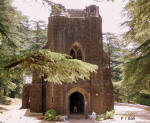
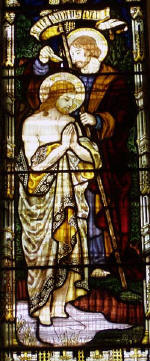

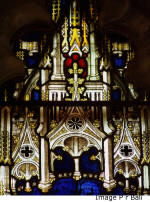
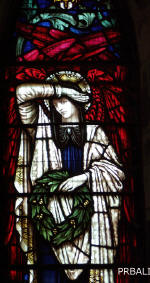


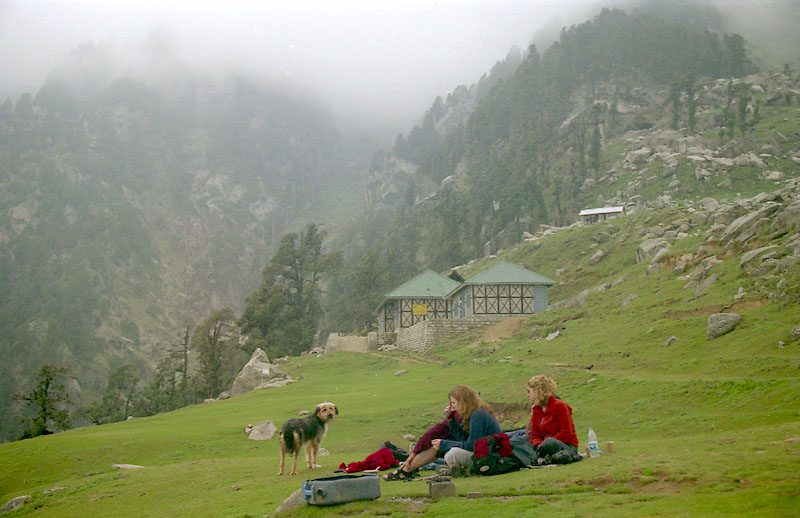 The tracks from Rawa, Dallake, Dharamkot and Bhagsu meet
at a ridge known as Galu Devi (2130m) which has a small temple and a water
point. From Galu Oevi onward the track is smooth and clear and ascends
through a mixed forest of oaks and rhododendrons. The track then gradually
gains height and winds round the ridges looking towards Dharamsala and the
Kangra valley. The last climb after a snow nullah rises abruptly with
steep ascents and the track weaves through twenty two curves making the
ascent tiring and difficult. On this track one can spot many types of
birds. Monals are in plenty. The black bear, leopards, pigs and wild goats
are also found in this region. There is a small forest bungalow at Triund
located on a big and green subsidiary ridge of the Dhauladhar range. The
forest bungalow was built some years ago.
The tracks from Rawa, Dallake, Dharamkot and Bhagsu meet
at a ridge known as Galu Devi (2130m) which has a small temple and a water
point. From Galu Oevi onward the track is smooth and clear and ascends
through a mixed forest of oaks and rhododendrons. The track then gradually
gains height and winds round the ridges looking towards Dharamsala and the
Kangra valley. The last climb after a snow nullah rises abruptly with
steep ascents and the track weaves through twenty two curves making the
ascent tiring and difficult. On this track one can spot many types of
birds. Monals are in plenty. The black bear, leopards, pigs and wild goats
are also found in this region. There is a small forest bungalow at Triund
located on a big and green subsidiary ridge of the Dhauladhar range. The
forest bungalow was built some years ago.